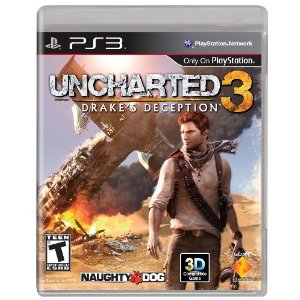Rated Teen; Reviewed on PS3
Uncharted 2 was perhaps as close to a perfect game as I’ve seen. It had flaws (and a lousy final boss fight) but it improved on the first game in nearly every way. Controls were streamlined, difficulty was smoothed and the scale of the story grew. Most importantly new characters were introduced and the characters we had grown to love from the first game were allowed to grow. The last conversation between Nate and Elena was one of the best endings to game ever.
The gameplay in Uncharted 3 evolves slightly from the previous games but is still tight. You can now shoot in pretty much any circumstance and toss grenades back at the bad guys (a great idea that unfortunately fails about as often as it succeeds). The weapons and tactics from the earlier games were great and return with only slight tweaks.
Unfortunately combat sequences seem less inspired and simpler this time around. Less destructable cover coupled with the new grenade mechanics and enemies that generally approach from the same direction mean battles tend to be less dynamic. Patient players can often sit tight under cover and draw enemies to them. There are still flashes of genius but they’re rare.
Like inFamous 2 this features a completely revamped and expanded melee combat system. While this system is better it also suffers from some of the same camera issues. On the hardest difficulty settings engaging in melee combat often means instant death as enemies have no compunction about spraying automatic weapons fire toward you and their allies. On the positive side the contextual aspects of the melee combat are impressive. Throw a punch near a bar and you might instead automatically grab a bottle and smash your foe in the face. Defend near a crate and you might toss them over it. It adds a wonderful cinematic layer to the events without increasing complexity or difficulty.
Much has been made of the set-pieces in the game and everything you’ve heard is right: they’re amazing. The forgotten subway station, the burning château, the sinking ocean liner, the crashing cargo plane and, finally, the required lost city. The problem is the gymnastics that the story has to perform to get the characters to those set pieces. The story often feels forced, awkwardly, into the available scenarios rather than flowing naturally.
Most of the problems with the game are centered on the story. The wonderful relationship between Nate and Elena remains in a holding pattern here as the same tropes used in the second game are reused here. Again we don’t see Elena at all until the second act and then we’re given only intimations of interesting events that we don’t get to see.
The central thread of the story is meant to examine Nate and Sully’s relationship and their relationship with the shadow organization that has dogged them for decades. The game succeeds on the first score but fails on the second. The villains are mediocre and their motivations (as well as those of the heroes) are difficult to understand. While the first game made your life dependent on your forward movement and the second pitted you against a madman intent on destroying the world this one is sadly vague until just before the end. We’re left with several interludes where the most obvious course of action is to simply stop playing, to gather your friends, cut your losses and run.
The Uncharted games were never notable for their originality and in fact they were, in all the best ways, clichéd. The clichés, both in the story and the gameplay were polished to a high-gloss-sheen. It would be overstating it to say that Uncharted 3 was a complete miss but it was definitely a step down for the series. But, like Pixar, even a bad Naughty Dog game is better than almost anything else out there.


1 Comment
Add a Comment